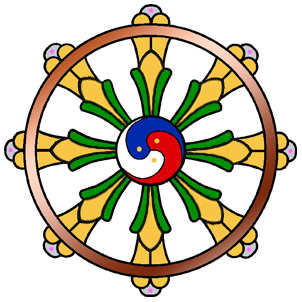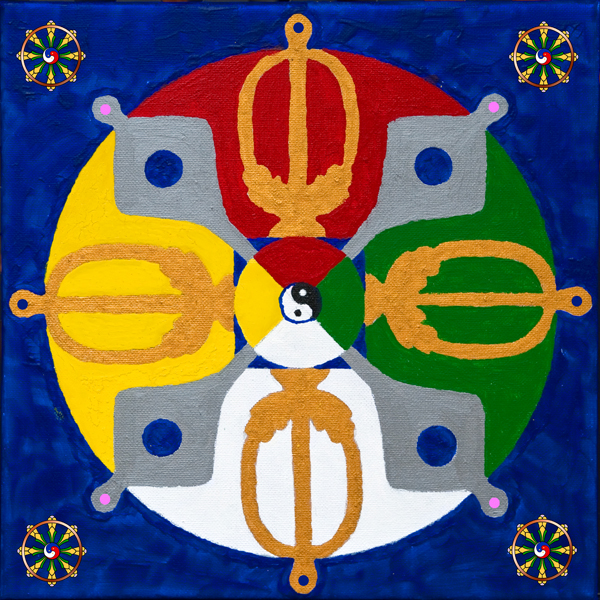Dharmarad Mandala Bad Oeynhausen, So. den 9. März.2014, 2:54 a.m.
Inspiration: Ende November 2013
Teilentwurf: Ende Dezember 2013
Angefangen zu konstruieren und zu malen: Ende Januar 2014 – beginning to construct and paint
Entwurf der kleinen Dharmaräder: 6. März 2014 – Construction of the little Dharma circles
Fertigstellung und Veröffentlichung: 11. März 2014 – Finsh and Publish
Mo. den 10. März 2014, ca. 17-20 h
Das Dharmarad Mandala.
Auf einem Mandala in traditionellen Farben,
Mitte: blau, Element Raum, Vater- Mutter Vairocana, Gesitesgift: Unwissenheit transformierte Weisheit: Allesumfassende Weisheit
Unten: weiß, Element Wasser, Vater- Mutter Akshobhya, Geistesgift: Hass, Abneigung
transformierte Weisheit: Spiegelgleiche Weisheit
Links: gelb, Element Erde, Vater- Mutter Ratnasambhava, Geistesgift: Stolz
transformierte Weisheit: Weisheit der Gleichheit
Oben: rot, Element Feuer, Vater- Mutter Amitabha, Geistesgift: Begehren
transformierte Weisheit: Weisheit der Unterscheidung
Rechts: grün, Element Luft, Vater- Mutter Amoghasiddhi, Geistesgift: Neid
transformierte Weisheit: Weisheit der All Vollendeten Handlung
erscheinen zwei Doppel Vajren, ein goldenes, männliches und ein silbernes weibliches und bilden so zusammen ein Dharmarad, das Tibetisch Buddhistische Symbol für die erste Belehrung, die Buddha zwei Rehen gab.
On a Mandala with the traditional colours,
Middle: blue, element space, Father- Mother Vairocana, mind poison: Ignorance
transformed wisdom: Allembracing Wisdom
Down: whithe, element water, Father- Mother Akshobhya, mind poison: Hate, aversion
transformed wisdom: Mirrorlike Wisdom
Left: yellow, element earth, Father- Mother Ratnasambhava, mind poison: Pride
transformed wisdom: Wisdom of Equality
Up: red, element fire, Father- Mother Amitabha, mind poison: Desire
transformed wisdom: Wisdom of Distinction
Right: green, element air, Father- mother Amoghasiddhi, mind poinson: Envy
transformed wisdom: Wisdom of All Accomplishing Action
appear two dobble vajra, one is a golden, male and one is a silvern, female and they both are shaping together a Dharma Circle.
Die acht Speichen des Dharmarades symbolisieren auch den Edlen Achtfachen Pfad zur Befreiung:
1 Rechte Erkenntnis
2 Rechte Gesinnung
3 Rechte Rede
4 Rechtes Handeln
5 Rechte Lebensweise
6 Rechtes Streben
7 Rechte Achtsamkeit
8 Rechtes sich Versenken
The eight spokes of the Dharma Circle symbolizes also the Noble Eighthfold Path to liberation:
1 Right Insight
2 Right Attitude
3 Right Speech
4 Right Handle
5 Right Mode of Life
6 Right Strive
7 Right Attentiveness
8 Right Meditation
Doch weder das Dharmarad noch die Symbolik eines Doppelvajra noch der Edler Achtfache Pfad hat mich inspiriert dieses Bild zu malen sondern der Versuch das männliche und das weibliche Prinzip und ihre Verbindung und ihr Potential tiefer zu durchleuchten und beiden Prinzipien im Sein einen gleichwertigeren Stellenwert zu geben.
But neither the Dharma Circle nor the symbolism of a dobble vajra nor the Noble Eightfold Path inspirered myself to paint this picture but the attempt to light up more deeply the male and female principles and their connection with each other and their potential and to give them both an equal place value.
Das weibliche Prinzip steht im Buddhismus für die Weisheit und das männliche Prinzip für die Methode. Buddhistische Thankas (Rollbilder) zeigen das männliche und weibliche Prinzip oft in sexueller Vereinigung (yab yum). Und Meditation darüber hat mir die Inspiration für dieses Bild gegeben.
In Buddhism the female principle represents wisdom, while the male represents method. Buddhist Thangkas (roll pictures) shows often the male and female principle in sexual union (yab yum). And meditation about this brought the inspiration of this picture to me.
Das Weibliche ist also die Weisheit und das Männliche ist das Prinzip, das diese Weisheit in der Vereinigung erfährt und in die Methode wandelt, beide richtig zu leiten. Das Weibliche ist ein schweigendes, eher passives Prinzip. Das männliche ein handelndes, eher aktives Prinzip. Ausgewogenheit, Balance, Würde und Respekt voreinander und füreinander sollten die Geschlechterbeziehungen mit sich bringen.
So the female is the wisdom and the male is the principle, which experiences this wisdom in the coupling and transforms it into the method to guide both of them right. The female is rather a silent, passive principle. The male rather an acting and active principle. Equipoise, balance, honour and respect for each other should bring the gender relationships with them.
Das männliche Doppelvajra habe ich in die Farben gemalt. Oft stehen Männer in einer Sache ganz „ihren Mann“, während ich das weibliche Doppelvajra in die Ecken und somit auf zwei Farben gemalt habe. Frauen stehen oft in mindestens zwei wesentlichen Bereichen „ihre Frau“, weil sie sich neben Beruf auch noch um die Kinder kümmern.
The male dobble vajra I painted into the colours. Males often in one thing „stand his man“, while I painted the female vajra into the corners and therefore into two colours. Females „stand their woman“ often in at least two sectors, profession and children.
In das weiblich Doppelvajra habe ich einen dharmadhatu blauen Kreis gemalt. Es hält sich hartnäckig das Gerücht, dass Frauen es schwerer hätten als Männer, Erleuchtung zu erlangen. Vielleicht mag das so sein. Auf jeden Fall ist die Frau dem Körper mehr verbunden, da sie Leben in sich heranwachsen lassen und gebären kann.
Into the female dobble vajra I put a blue circle. There is a persistant rumour that females have more difficulties to become enlightent then males. Maybe that is so. In every case the female is more connected to the body, because in her life can grow and be born.
Vielleicht ist es so, wie ich es gemalt habe, dass das Weibliche tiefer mit dem Samboghakaya verbunden ist und in einer rosafarbenen Blüte erblüht, während das Männliche mehr mit dem tiefsten Urgrund verbunden ist, was ich durch den kleinen blauen Punkt im obersten Ende des männlichen Doppelvajra ausgedrückt habe.
Maybe it is like I have painted, that the female is more connected with the Samboghakaya and blossoms in a rose flower, while the male is more connected with to most deep, the very basis, what I showed with the blue point in the ends of the male dobble vajra.
Das Mandala baut sich in drei Ebenen auf: In der Mitte ist das Yin/ Yang Symbol. Es steht für die Einheit, Gott, Allah, das Dharmakaya. Die nächste Ebene symbolisiert das Sambhogakaya. Die unsichtbaren Reiche der Engel, Buddha Energien, Elfen, Djinns, Dharmaschützern, etc. Und die dritte, äußerste Ebene symbolisiert das Nirmanakaya. Diese irdische Welt (eigentlich in seiner Vollkommenheit).
The Mandala is constructed in three levels. In the middle,there is the yin/ yang symbol. It represents the Unity, God, Allah, the Dharmakaya. The next level represents the Samboghakaya. The unseen realms of the Angels, Buddha Energies, Faries, Djinns, Dharma Protectors, etc. And the third, outermost level represents the Nirmanakaya. This earthly world (actually in its perfection).
Es ist ein gutes Meditationsbild. Du kannst es Dir während der Meditation betrachten und versuchen es zu „erspüren“. Ein nächster möglicher Schritt kann es sein, die Augen zu schließen und Dir vorzustellen, Du bist in der Mitte des Mandalas, sitzt auf dem Mandala, es durchstrahlt Dich vollkommen. (Dann ist gelb rechts und grün links, rot hinter Dir und weiß vor Dir). Und die beiden Doppelvajren sind das Gerüst, dass Dir Stabilität gibt, egal durch welche Stürme Du gehst.
It is a good meditation picture. You can look at it during your meditaion and try to „sense“ it. A next possible step might be to close your eyes and imagine that you are in the middle of the Mandala, you sit on it and it is totally radiating through you. (In this case, yellow is right and green is left, red behind and white in front of you). And the both dobble vajras are the framework, that gives stability no matter through what of storms you are going.
Die vier Dharmaräder in den Ecken symbolisieren wiederum die vier Element Farben, während das Dharmarad Mandala in der Mitte den Raum symbolisiert, indem Alles existiert. Auch können die vier kleinen Räder für Kinder stehen.
Es gibt den Ausdruck: Das Dharmarad drehen, der für das Lehren des Dharma (der Lehre), steht.
Freude und Segen
Chrisdiana
The four Dharma Circles in the corners are symbolysing the four element colours while the Dharma Mandala in the middle symbolizes the Space in which exists all. Also, the for little circles could stand for children.
There is the term of „turning the Dharma circle“, which is standing for the teaching of Dharma /the teachings).
Joy and Blessing
Chrisdiana
Dharmarad Mandala - Erklärungen / Explanations (PDF)

